
Tips and Tricks: Here's how to tackle homeschooling
Schools remain closed in our country for most students and it's not yet clear when school routines will get back to normal. Until that point, it means that children are being taught at home. This means that parents of school-aged children are facing a special challenge. After their own work in the home office, they also have to be available as a learning companion for their children and their first point of contact for all questions regarding their studies and homework. For this reason, it's often helpful to explore the content to be learned in a playful way.









